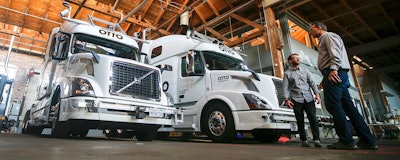
 Joe Egertson
Joe Egertson The transportation industry doesn’t often make mainstream news, but futuristic autonomous trucks have become a hot topic in the public eye. Some of this attention is no doubt due to major companies like Tesla and Volvo developing their own versions of automated semis, but several lesser-known names already have self-driving vehicles on the road.
For instance, Embark has been using autonomous trucks to haul refrigerators from Texas to California since October. Meanwhile, Uber has used self-driving rigs to transport cases of beer across Colorado.
Some people look at these pilot tests and envision a future flush with self-driving trucks hauling goods along our roadways. They dream of the resources that could be gained from a purely autonomous world, assuming the technology will solve every problem in the logistics industry.
To be fair, this technology could play a major role in meeting the industry’s demand and sustainability needs. The carrier workforce is aging, and drivers have not been replaced by younger generations. Plus, humans need accommodations like food and sleep that autonomous trucks can do without.
For all this incredible progress, today’s models still require human drivers to monitor the system and deal with emergencies. Major players in the logistics world have become distracted with this shiny new thing, causing them to overlook other sustainability practices that can help them immediately. Sustainability is critical to our future and should be top of mind when developing an efficient supply chain strategy.
Taking Responsibility for Our Part
The freight transportation sector is a major contributor to air pollution — a problem that will not go away on its own. Shipments of U.S. goods are expected to increase by 45 percent by 2040, which will cause growth in freight emissions to surpass emissions growth from all other transport (including passenger transportation).
Instead of standing on the sidelines, players in the freight industry can take steps to reduce any negative effects on public health and the environment. In the supply chain, sustainability efforts are fully aligned with efficiency and cost savings. In other words, you can save money by adopting sustainable practices like package and shipment optimization and using fuel-efficient modes like pipelines, rails, and ocean.
Shipment optimization focuses on the better utilization of equipment — ensuring trucks are not traveling without a payload. An effort to minimize empty miles translates to less wasted fuel for unproductive purposes.
In addition, innovative packaging and product design can have a tremendous impact on the supply chain. Beyond reducing material waste, this packaging can allow for more units to fit on a truck, resulting in fewer trucks moving the same number of products. Most companies can use thinner plastics or recycled cardboard without sacrificing customer satisfaction. You might even improve your image by using more eco-friendly materials.
It’s important to also consider alternative methods of transportation — particularly if you deal with global commerce. Countries all over the world are investing in infrastructure projects to ease congestion, create more efficient ports, and improve rail systems.
Individual companies within the shipping industry could make major sustainability strides by taking advantage of these tactics. Beyond endearing your company to potential customers, these practices can help you save a significant amount of money over time.
Untapped Potential in the Supply Chain
Beyond autonomous vehicles, a number of technology advancements hold incredible promise for sparking sustainability in the supply chain. Here are four that offer a lot of potential:
No. 1 - Platooning
Autonomous vehicles can help with sustainability efforts, but only if they’re used with the right strategies. This is where platooning comes in. Platooning involves multiple trucks following each other closely to reduce wind resistance while optimizing speeds and routes. An experiment in platooning trucks produced significant reductions in fuel consumption and emissions.
More autonomous trucks on the road will also likely increase safety. It might be a hard pill to swallow, but we should not wait until they’re flawless to put autonomous trucks on the roads. A report from the RAND Corp. argues that if they’re even 10 percent safer than humans, widespread adoption of autonomous vehicles would save 3,000 lives every year.
No. 2 - Electric Trucks
Massive fuel savings and zero emissions are a possibility with electric trucks. Until we’re able to fully transition to electric trucks, however, the electric axle provides a fantastic steppingstone toward increased sustainability.
Three major fleets are now testing this technology, which generates electricity while coasting or on downgrades; the axle then uses that power during launch and upgrades. In doing so, it reduces emissions and saves as much as 15 percent in fuel consumption.
No. 3 - Load and Route Optimization
Third-party logistics (3PL) providers use advanced technology and software to help shippers consolidate loads to utilize as much truck space as possible and maximize efficiency. This reduces total emissions by cutting back on the number of trucks on the road.
Since 3PLs have visibility over multiple transportation networks, they can capture capacity unloading for one client and dispatch that same truck to handle a nearby load for a different client — reducing empty miles. According to the Environmental Protection Agency, route-optimization strategies such as this can reduce fuel consumption by 20 percent or more. These high-end savings result from using a 3PL combined with a tech-based transportation management system.
No.4 - Longer Combination Vehicles (LCVs)
Using multiple trailers or longer trucks enables a single driver to carry more freight — leading to reduced fuel consumption and emissions. This might seem counterintuitive considering LCVs are slightly less fuel-efficient per mile, but fewer trucks traveling down the road leads to net gains. Once again, the EPA recommends this strategy for increased fuel efficiency on a ton-mile basis.
Autonomous trucks have been getting most of the press — and for good reason — but they are not the only important technology out there. They certainly are not the only way to improve sustainability in supply chains. As responsible businesses staffed by individuals who need clean air to survive, companies that function in the logistics sector should do their part to implement new technology and lead the way to more sustainable supply chains. In addition to helping the planet, these seemingly small shifts will bolster your bottom line.
Joe Egertson is the CEO of Sheer Logistics.



















